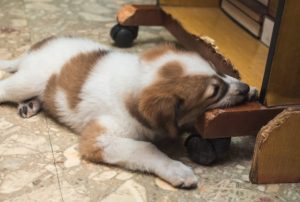How to Stop Your Dog from Chewing Furniture: Effective Strategies and Tips. Hey there, fellow dog lovers! If you’ve got a furry friend who thinks your furniture is their personal chew toy, you’re definitely not alone. I’ve been there too, watching in horror as my puppy turned my favorite chair into a chew toy. But don’t worry! With a bit of understanding and some solid strategies, you can put an end to this pesky behavior. Let’s dive into the reasons behind why our dogs chew and how we can redirect that energy to save our beloved couches!
Understanding Chewing Behavior
First off, it’s important to recognize that chewing is a completely natural behavior for dogs. Puppies, especially, go through a teething phase where they’re just itching to chew on anything they can sink their little teeth into. But even older dogs can chew for various reasons—boredom, anxiety, or just plain curiosity.
Picture this: a dog sees a couch leg and thinks, “What’s this? I’ve got to check it out!” Or maybe they’re just feeling a bit anxious when left alone and need an outlet for that nervous energy. Whatever the reason, understanding what’s driving your dog to chew can help us address it more effectively.

Prevention Strategies
1. Provide Appropriate Chew Toys
One of the best ways to stop your dog from munching on furniture is to give them something else to chew on. Invest in some durable chew toys that are designed for heavy-duty chewing. Look for toys made from rubber or nylon, which are typically more long-lasting than plush toys.
Encourage your dog to use these toys by playing games with them. Toss a toy around to pique their interest, or use treats to make the toy even more enticing. I found that my dog loves a good challenge, so puzzle toys that release treats kept him occupied for ages!
2. Create a Stimulating Environment
Dogs can get bored just like we do, and a bored dog is often a destructive one. Make sure your furry friend has plenty of mental and physical stimulation. Incorporate interactive toys, engage in regular playtime, and take them for walks. The more you can keep their mind busy, the less likely they are to chew on your furniture.
You can also rotate their toys regularly to keep things fresh and exciting. A toy that was once ignored might suddenly become the most interesting thing in the room just because it’s new again!
3. Establish Boundaries
Dog-proofing your home is another great way to tackle the furniture-chewing issue. It might feel a bit like you’re living in a dog-proof fortress at first, but it’s all worth it in the long run. Start by moving any valuable or easily damaged items out of reach. Consider using pet-safe sprays or bitter deterrents on furniture you want to protect. Just a light spritz can make your couch smell unappetizing to your pup, discouraging them from taking a bite.

Training Techniques
Positive Reinforcement
Training is a crucial part of curbing unwanted chewing. Positive reinforcement is a powerful tool! When you catch your dog chewing on their toys instead of the furniture, praise them and give them a treat. Over time, they’ll start to associate chewing on their toys with good things.
Also, teaching your dog simple commands like “leave it” or “no” can be incredibly helpful. Whenever they reach for the furniture, a firm “no” followed by redirecting them to their toy can work wonders. Consistency is key here—everyone in your household should be on the same page to reinforce these commands.
Consistency in Commands
Just like we don’t want to confuse our friends with mixed messages, our dogs need clarity too. Make sure everyone in your household uses the same commands and reinforces the same rules. If one person allows the dog to chew on the furniture while another doesn’t, it’ll just lead to confusion.

Managing Anxiety
Sometimes, chewing can stem from anxiety. If you notice your dog getting restless when left alone, they might be chewing to cope. It helps to identify what might be triggering their anxiety.
Creating a safe space for your dog to relax can make a big difference. A cozy bed in a quiet corner or a crate can serve as their little haven. Additionally, there are calming aids available, like anxiety wraps and pheromone diffusers, that can help soothe your pup.
When to Seek Professional Help
If you’ve tried various strategies and your dog is still chewing furniture despite your best efforts, it might be time to seek help from a professional. A dog trainer or behaviorist can offer tailored advice based on your dog’s specific needs. Sometimes, a little expert guidance can go a long way in resolving stubborn issues.
Conclusion
So there you have it—my top strategies for stopping your dog from chewing on your furniture! Remember, it’s all about understanding why your pup is chewing and redirecting that behavior. It might take some time and patience, but with the right approach, you can protect your furniture while keeping your dog happy and engaged.
Keep in mind that building a bond with your dog during this process is vital. Celebrate those small victories, and don’t be too hard on yourself or your furry friend. After all, we’re in this together!









Discussion about this post